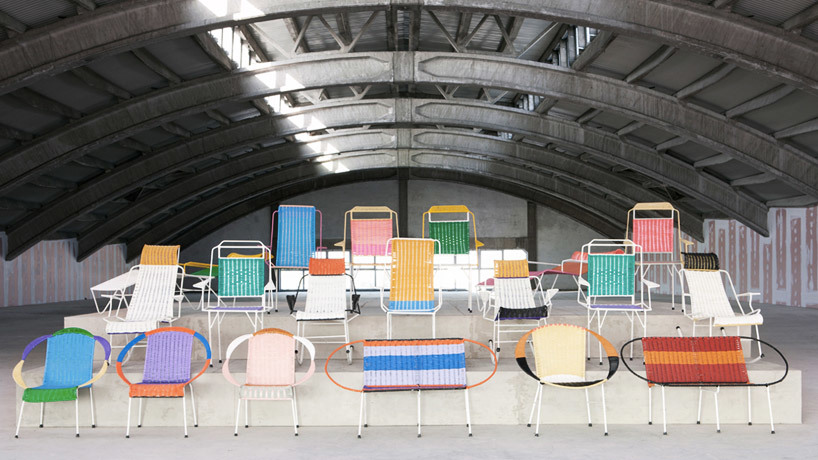The rediscovery of old craft techniques by designers has been gaining momentum in recent years and with big name designers like Patricia Urquiola constantly looking at traditional crafts for inspiration, it’s no wonder. This practice has resulted in what for many of us is a first time experience with wonderful styles and processes that had been hidden in semi-obscurity in their native lands. Such was the case with Urquiola’s 'Sardinian' rugs for Moroso from 2006. The rugs that resulted from Urquiola's insatiable curiosity for materials and methods used the highly geometric motifs and monolevel weaving of the Sardinian Pibiones technique but were reinvigorated with contemporary colours and patterns.
It’s obvious that rugs would be a likely candidate for the rediscovery of weaving techniques as commercially tufted rugs struggle to compete with the subtle complexity of hand knotted and woven varieties. Rug companies such as Jan Kath, cc-tapis, Golran and Nodus show that a truly great rug benefits from the combination of contemporary design and the traditional skills of the artisan rug makers of Tibet, Nepal, India, Pakistan, Turkey and Morocco.
However, it’s in other areas of design that weaving has been used in more surprising ways in recent times – particularly in lighting but also in table accessories and furniture.
The new lights by prodigious Swedish designers, Claesson Koivisto Rune (CKR) for Made in Mimbre are the perfect example. Made by hand in Chile, the lights have an organic quality that is so readily achieved in woven objects. While the methods for making these lights are fairly traditional, the shapes and collaborative nature of the project are something entirely new. This growing recognition of the value of the artisan in the process and the need for the designer to learn from them has only kicked in over recent years as a new wave of more socially aware young designers have moved from exploitation of traditional labour for reduced manufacturing costs, to a position where the designer’s involvement makes traditional crafts sustainable in a highly technical age (and in doing so improving the lives of the workers).
The PET lamp is one of a number of recent projects that illustrate how designers have been able to use weaving as a method to bring about positive social outcomes. In the Summer of 2011, Spanish product designer, Alvaro Catalán de Ocón was on a visit to Colombia when he was invited to form part of a project focused on the reuse of plastic bottles (PET). Hélène Le Drogou, a psychologist and activist concerned with the plastic waste that contaminates the Colombian Amazon, invited him and a group of other creatives to devise a project to help alleviate the problem. They decided that the local textile tradition could be utilised to make something special from an object with a short and specific lifespan - like a plastic bottle - by enriching it with local culture. In August 2012 Alvaro returned to Bogotá, where he created a workshop of artisans from Cauca who had been displaced by a guerilla war. The project was eventually presented for the first time in 2013 at Spazio Rossana Orlandi in Milan and has since been shown and sold around the globe.
The Marni 100 chair project employs the skills of Colombian ex-prisoners. Armed with a Marni colour palette the artisans are able to reinvent a number of basic steel chair frames with a huge number of different patterns. The simple chairs are made of steel rod wrapped in PVC tubing but their unique shapes and colours have made them an instant success with the project being nominated for a London Design Museum award for Furniture in 2013.
Italian born, Barcelona based architect, Benedetta Tagliabue, the co-founder of the enormously respected architectural practice, EMBT, is a fan of weaving in all it’s forms and used the technique for the roof panels on her critically acclaimed Spanish Pavilion at the 2010 Shanghai Expo.
The Spanish Pavilion used thousands of woven bamboo panels asa diaphanous outer skin – a blend of Chinese and Spanish materials and practices. This year she succumbed to the powers of weaving again - this time in an object with a more human scale - and designed a woven wicker chair and sofa for Spanish rattan specialist, Expormim. Unlike the extremely beautiful but more rigid and symmetrical rattan designs of Franco Albini for Italian company, Vittorio Bonacina, her ‘Tina’ chair is allowed to flex with the shifts of the body to improve comfort without having to resort to upholstery that generally compromises the beauty of a woven furniture form.
Closer to home, Dennis Abalos a Sydney designer, released his ’Woven’ fruit bowl through Workshopped in 2011. The use of rattan and Abaca fibre creates an open, soft and highly textural object that works beautifully against the background of hard architectural surfaces such as stone, stainless steel and Corian™. Abalos has won several awards and competitions for his woven objects including being the winner of the Red Dot Design Award Design Concept, for his 'Snug' chair and a finalist in both the Bombay Sapphire Design Discovery Award and Launchpad InDesign Design Of The Year, for his 'Woven' fruit bowl - all in 2011.











